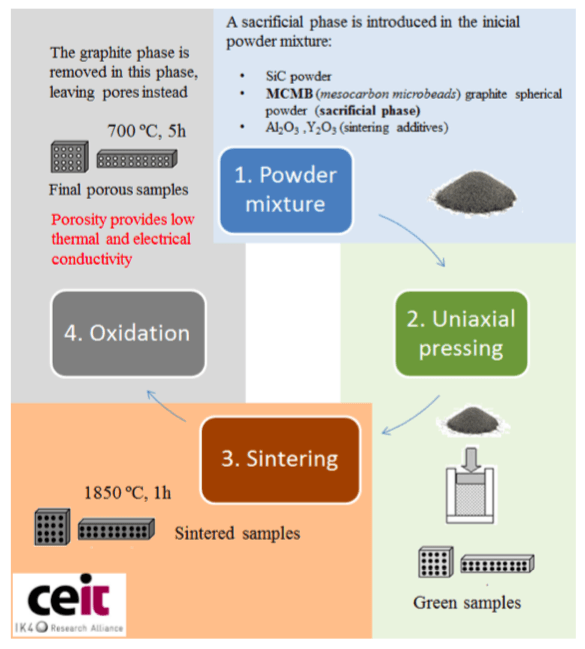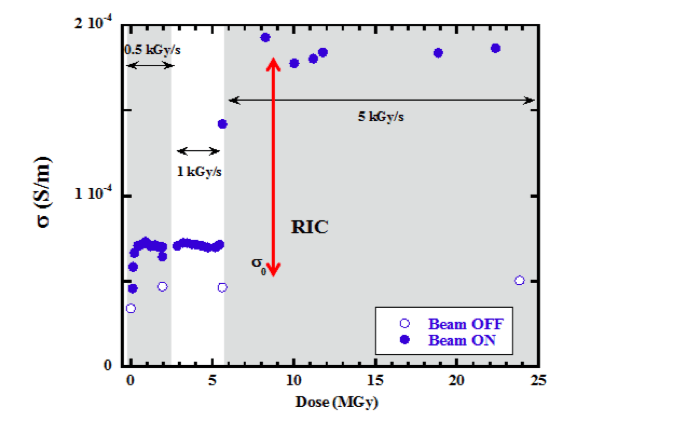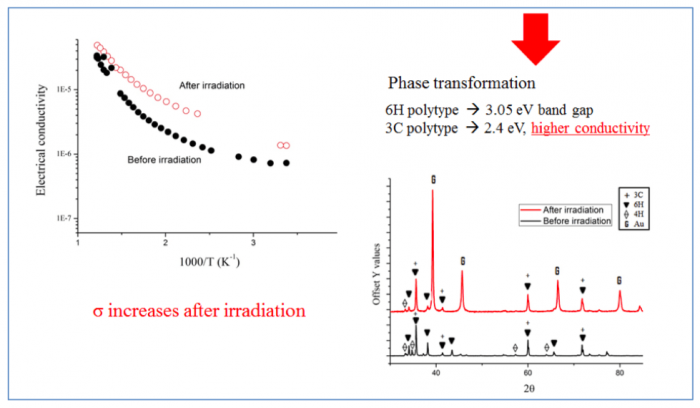
Published by Marta Malo
CIEMAT, National Fusion Laboratory, 28040, Madrid, Spain
These findings are described in the article entitled Stability of porous SiC based materials under relevant conditions of radiation and temperature, recently published in the Journal of Nuclear Materials (Journal of Nuclear Materials 509 (2018) 54-61).This work was conducted by Marta Malo and Teresa Hernandez from CIEMAT, and Carlota Soto and Carmen García-Rosales from the University of Navarra.
Silicon carbide is a semiconductor with excellent properties which has been proposed for applications which require extraordinary high resistance to temperature, radiation, and corrosion. In particular, SiC-based materials are candidates to be used as flow channel inserts (FCI), which are part of the liquid breeder blankets and which must provide thermal/electrical insulation, and also protection against corrosion to the more susceptible stainless steel which is used to fabricate the general machine structures.
Materials working in a future fusion reactor will be subjected to extreme temperature and radiation conditions which are able to modify their properties. In particular, the as called “functional materials,” those which are considered for not exclusively structural applications (insulators and semiconductors), are more susceptible to radiation than metals. Studies have shown that changes in the microstructure and electrical properties of SiC take place as a consequence of irradiation. Both initial and radiation-induced modified properties strongly depend on the crystal structure, impurities, and additives that the fabrication process determine.
The Ceit-IK4 Technology Center (San Sebastian, Spain) and the Research Center for Energy, Environment, and Technology (CIEMAT) in Madrid work together in the development of SiC-based materials. Direct feedback between the manufacturing and testing laboratories permits to identify material weak points in order to improve the final material.
SiC material with suitable thermal and electrical properties, acceptable mechanical stability and reducing cost was fabricated by a method based on the sacrificial template technique. With this method, porous SiC with porosities between 8 and 70% and different properties can be produced.

Figure 1. The fabrication process for porous SiC by means of the sacrificial template technique. Image courtesy CEIC
For this work, samples with ~50 % porosity have been tested, and radiation/high temperature effects in both the microstructure and the electrical conductivity were examined. Irradiations at operating temperatures are carried out with 1.8MeV electrons at the Ciemat HVEC Van de Graaff installation. Electrical conductivity is measured in situ before, during and after irradiation. The crystalline structure before and after irradiation is examined by XRD analysis, using a Pananlytical X-Pert diffractometer.
During irradiation. Temporary effects.
Measuring electrical conductivity during irradiation is a complex task, one of the difficulties being that this has to be done at a distance (due to the high radiation levels at the accelerator room that make not possible the human presence), that requires more than 25 m cables with special shielding to minimize noise. However, it is essential because some of the effects produced by radiation fade out when radiation ends, and we need to know what exactly will happen during future operation at a fusion reactor.
Radiation-Induced Conductivity (RIC) is the increase of the electrical conductivity that takes place during irradiation due to the excitation of charge carriers into the conduction band and is one of the main limitations which need to be considered in the insulating materials for fusion applications. While the increase can achieve several orders of magnitude for some materials, RIC was found to be tolerable in the SiC samples investigated in this work.

Figure 2.The electrical conductivity of porous SiC. with a 5 % of sintering aids measured with/without irradiation with 1.8 MeV electrons at three different dose rates (0.5, 1, and 5 kGy/s). Image published with permission from Elsevier from https://doi.org/10.1016/j.jnucmat.2018.06.009
Before and after irradiation. Permanent effects. XRD analyses.
The electrical conductivity has been measured from room temperature to 550 ºC before and after irradiation (23 MGy total dose). An increase in the value of the conductivity is observed over the whole range, the lower the temperature the more evident. The XRD data for the sample before irradiation shows a high crystallinity, with the presence of hexagonal phases (6H and 4H polytypes). The changes in the electrical conductivity may be directly associated to the crystalline structure modification which was identified. The electrical properties depend on the structure, with varying bandgap depending on the SiC polytype (3.2, 3.05, and 2.4 eV for 6H, 4H and 3C respectively). The reduced bandgap for the 3C structure after irradiation imply an increase in the electrical conductivity.

Figure 3. Electrical conductivity and XRD patterns before and after irradiation (23 MGy). XRD data represents signal normalized to the maximum intensity peak (gold signal stemming from the metal electrodes deposited onto the sample for the conductivity measurements was not taken into account). As received material shows diffraction lines for hexagonal phases (6H and 4H), some of which are coincident with cubic structure. After irradiation, a signal corresponding to the peaks which exclusively belong to 6H diffractogram shows a relative reduction. This is indicative of a 6H to 3C transformation. Image published with permission from Elsevier from https://doi.org/10.1016/j.jnucmat.2018.06.009
The examined sample showed an increase in the electrical conductivity after irradiation (about 90 % increase at 20 °C). In addition, a transformation from hexagonal to cubic crystal structure is observed, which might be the primary reason for this modification.
Although no serious RIC was found, and electrical conductivity both before and after irradiation is below the maximum which has been considered acceptable for FCI (∼10 S/m), longer irradiations at more representative doses for the fusion scenery should be performed to validate these materials. Moreover, attention should be paid to the observed phase transformation and the amorphization reported by different authors which will affect not only the stability of the dense SiC deposition and the FCI modules assembling that this application requires but also the suitability of this material for structural applications. However, further tests are necessary in order to check the reproducibility of these measurements.









